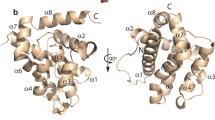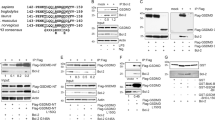Abstract
We have studied ceBNIP3, the orthologue of BNIP3 in C. elegans. Sequence analysis reveals that the different domains of BNIP3 have been conserved throughout evolution. ceBNIP3 contains a C-terminal transmembrane (TM) domain, a conserved domain (CD) of 19 amino acids, a BCL-2 homology-3 (BH3)-like domain and a PEST sequence. ceBNIP3 is expressed primarily as a 25 kDa monomer and a 50 kDa homodimer. After transfection, ceBNIP3 protein is rapidly degraded through a ubiquitin-dependent pathway by the proteasome. Like BNIP3, the TM domain of ceBNIP3 mediates the localization of the protein to mitochondria and is also necessary for homodimerization and cell death in mammalian cells. Neither the putative BH3 domain nor conserved domain is necessary for killing. ceBNIP3 protein interacts with CED-9 and BCL-XL, but unlike other pro-apoptotic BCL-2 family members, the BH3-like domain does not participate in dimerization. The ceBNIP3 TM domain mediates interaction with both CED-9 and BCL-XL. ceBNIP3 interacts with CED-3 but co-expression of CED-3 and ceBNIP3 does not significantly enhance induction of cell death in the presence or absence of CED-4. ceBNIP3 kills mammalian cells by a caspase-independent mechanism. In conclusion, we find that although ceBNIP3 interacts with CED-9 and CED-3 it kills by a BH3- and caspase-independent mechanism.
This is a preview of subscription content, access via your institution
Access options
Subscribe to this journal
Receive 50 print issues and online access
$259.00 per year
only $5.18 per issue
Buy this article
- Purchase on Springer Link
- Instant access to full article PDF
Prices may be subject to local taxes which are calculated during checkout









Similar content being viewed by others
References
Alnemri ES, Livingston DJ, Nicholson DW, Salvesen G, Thornberry NA, Wong WW and Yuan J. . 1996 Cell 87: 171.
Bertin J, Nir WJ, Fischer CM, Tayber OV, Errada PR, Grant JR, Keilty JJ, Gosselin ML, Robison KE, Wong GH, Glucksmann MA and DiStefano PS. . 1999 J. Biol. Chem. 274: 12955–12958.
Boyd JM, Malstrom S, Subramanian T, Venkatesh LK, Schaeper U, Elangovan B, D'Sa-Eipper C and Chinnadurai G. . 1994 Cell 79: 341–351.
Chen F, Hersh BM, Conradt B, Zhou Z, Riemer D, Gruenbaum Y and Horvitz HR. . 2000 Science 287: 1485–1489.
Chen G, Cizeau J, Park JH, Bozek G, Bolton J, Dubik D and Greenberg AH. . 1999 J. Biol. Chem. 274: 7–10.
Chen G, Ray R, Dubik D, Shi L, Cizeau J, Bleackley RC, Saxena S, Gietz RD and Greenberg AH. . 1997 J. Exp. Med. 186: 1975–1983.
Chinnaiyan AM, O'Rourke K, Lane BR and Dixit VM. . 1997 Science 275: 1122–1126.
Chowdary DR, Dermody JJ, Jha KK and Ozer HL. . 1994 Mol. Cell. Biol. 14: 1997–2003.
Conradt B and Horvitz HR. . 1998 Cell 93: 519–529.
Ellis HM and Horvitz HR. . 1986 Cell 44: 817–829.
Fenteany G, Standaert RF, Lane WS, Choi S, Corey EJ and Schreiber SL. . 1995 Science 268: 726–731.
Gietz RD, Triggs-Raine B, Robbins A, Graham KC and Woods RA. . 1997 Mol. Cell. Biochem. 172: 67–79.
Green DR and Reed JC. . 1998 Science 281: 1309–1312.
Hengartner MO, Ellis RE and Horvitz HR. . 1992 Nature 356: 494–499.
Hengartner MO and Horvitz HR. . 1994 Cell 76: 665–676.
Hochstrasser M. . 1996 Annu. Rev. Genet. 30: 405–439.
Horton RM, Ho SN, Pullen JK, Hunt HD, Cai Z and Pease LR. . 1993 Meth. Enzymol. 217: 270–279.
Horvitz HR, Shaham S and Hengartner MO. . 1994 Cold Spring Harb. Symp. Quant. Biol. 59: 377–385.
Inohara N, Koseki T, del Peso L, Hu Y, Yee C, Chen S, Carrio R, Merino J, Liu D, Ni J and Nunez G. . 1999 J. Biol. Chem. 274: 14560–14567.
Kelekar A and Thompson CB. . 1998 Trends Cell Biol. 8: 324–330.
Li B and Dou QP. . 2000 Proc. Natl. Acad. Sci. USA 97: 3850–3855.
Matsushima M, Fujiwara T, Takahashi E, Minaguchi T, Eguchi Y, Tsujimoto Y, Suzumori K and Nakamura Y. . 1998 Genes Chromosomes Cancer 21: 230–235.
Miura M, Zhu H, Rotello R, Hartwieg EA and Yuan J. . 1993 Cell 75: 653–660.
Monney L, Otter I, Olivier R, Ozer HL, Haas AL, Omura S and Borner C. . 1998 J. Biol. Chem. 273: 6121–6131.
Ng FWH, Nguyen M, Kwan T, Branton PE, Nicholson DW, Cromlish JA and Shore GC. . 1997 J. Cell Biol. 139: 327–338.
Ng FWH and Shore GC. . 1998 J. Biol. Chem. 273: 3140–3148.
Ohi N, Tokunaga A, Tsunoda H, Nakano K, Haraguchi K, Oda K, Motoyama N and Nakajima T. . 1999 Cell Death Differ. 6: 314–325.
Ray R, Chen G, Vande Velde C, Cizeau J, Gietz RD, Reed JC and Greenberg AH. . 2000 J. Biol. Chem. 275: 1439–1448.
Rogers S, Wells R and Rechsteiner M. . 1986 Science 234: 364–368.
Seshagiri S and Miller LK. . 1997 Curr. Biol. 7: 455–460.
Spector MS, Desnoyers S, Hoeppner DJ and Hengartner MO. . 1997 Nature 385: 653–656.
Vande Velde C, Cizeau J, Dubik D, Alimonti J, Israels S, Hakem R and Greenberg AH. . 2000 Mol. Cell. Biol. 20: 5454–5468.
Vaux DL, Weissman IL and Kim SK. . 1992 Science 258: 1955–1957.
Vaux DL and Korsmeyer SJ. . 1999 Cell 96: 245–254.
Wu D, Wallen HD and Nunez G. . 1997 Science 275: 1126–1129.
Yang X, Chang HY and Baltimore D. . 1998 Science 281: 1355–1357.
Yang Y, Fang S, Jensen JP, Weissman AM and Ashwell JD. . 2000 Science 288: 874–877.
Yasuda M, Theodorakis P, Subramanian T and Chinnadurai G. . 1998a J. Biol. Chem. 273: 12415–12421.
Yasuda M, D'Sa-Eipper C, Gong X-L and Chinnadurai G. . 1998b Oncogene 17: 2524–2530.
Yasuda M, Hun J, Dionne CA, Boyd JM and Chinnadurai G. . 1999 Cancer Res. 59: 533–537.
Zou H, Henzel W, Liu X, Lutschg A and Wang X. . 1997 Cell 90: 405–413.
Acknowledgements
We thank Dr Dwight Nance for help in the confocal studies, Dr Radhey Gupta for anti-HSP60 antibody, Dr Gabriel Nunez for providing the CED-9 and CED-3 cDNAs, Dr Gordon Shore for the Bcl-XL plasmid, Dr Peter Okkema for the C. elegans cDNA library and Dr Harvey Ozer for the TS20 cell line. Also, we thank Laurie Lange for her technical help with the FISH microscope. This work was supported by the NCIC and Canadian Health Research Institute.
Author information
Authors and Affiliations
Rights and permissions
About this article
Cite this article
Cizeau, J., Ray, R., Chen, G. et al. The C. elegans orthologue ceBNIP3 interacts with CED-9 and CED-3 but kills through a BH3- and caspase-independent mechanism. Oncogene 19, 5453–5463 (2000). https://doi.org/10.1038/sj.onc.1203929
Received:
Revised:
Accepted:
Published:
Issue Date:
DOI: https://doi.org/10.1038/sj.onc.1203929
Keywords
This article is cited by
-
Geniposide augments apoptosis in fibroblast-like synoviocytes by restoring hypoxia-enhanced JNK-BNIP3-mediated autophagy
Inflammation Research (2023)
-
BNIP3 phosphorylation by JNK1/2 promotes mitophagy via enhancing its stability under hypoxia
Cell Death & Disease (2022)
-
Mieap-regulated mitochondrial quality control is frequently inactivated in human colorectal cancer
Oncogenesis (2016)
-
Role of BNIP3 and NIX in cell death, autophagy, and mitophagy
Cell Death & Differentiation (2009)
-
The role of Bcl-2 family member BNIP3 in cell death and disease: NIPping at the heels of cell death
Cell Death & Differentiation (2009)



